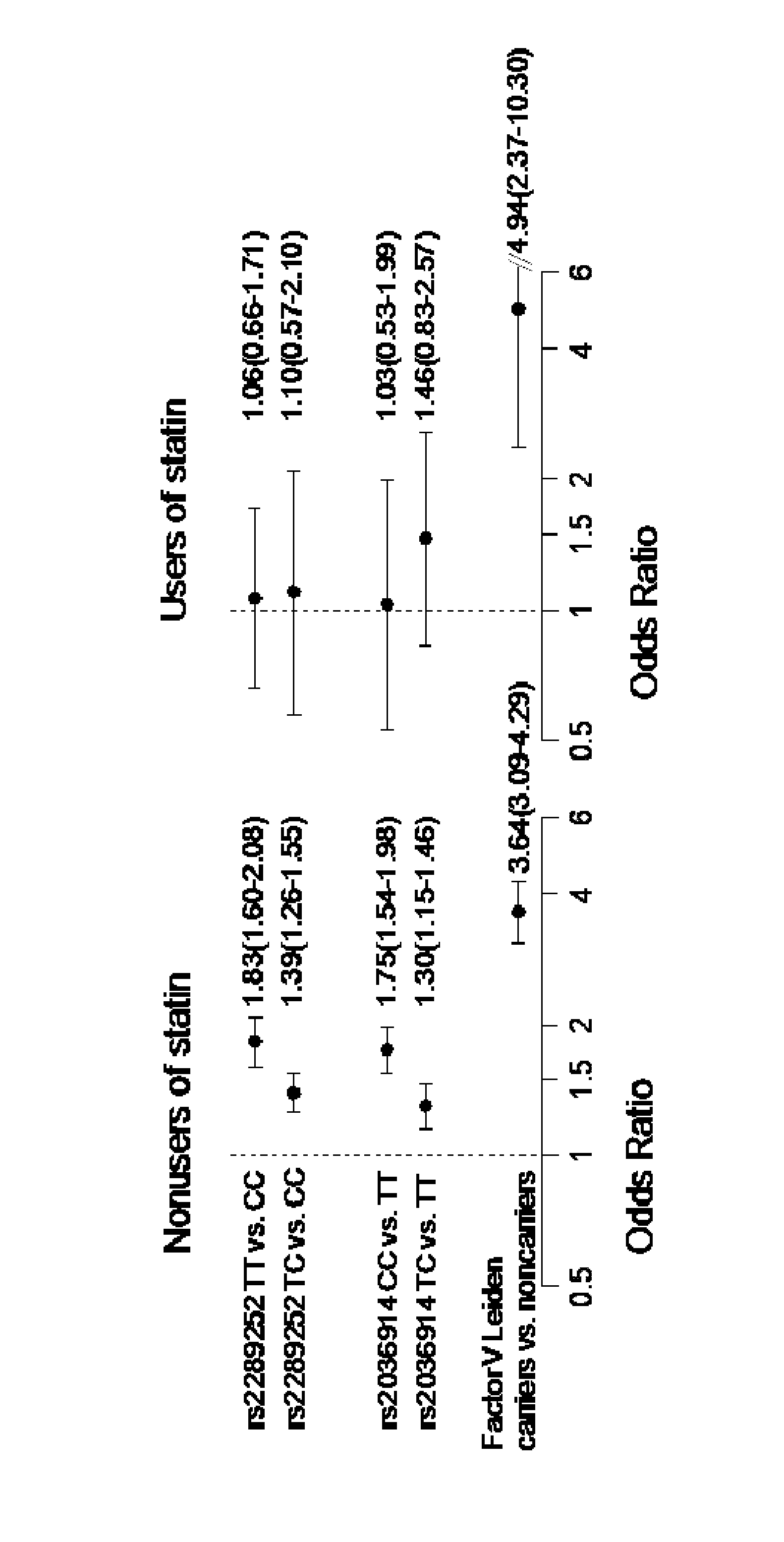Genetic polymorphisms associated with venous thrombosis and statin response, methods of detection and uses thereof
a technology of venous thrombosis and statin, which is applied in the field of disease risk and drug response, can solve the problems of affecting the normal blood circulation, affecting the normal blood flow, and reducing the circulating ldl, so as to and reduce the risk of v
- Summary
- Abstract
- Description
- Claims
- Application Information
AI Technical Summary
Benefits of technology
Problems solved by technology
Method used
Image
Examples
example 1
SNPs Associated with Response to Statins for Reducing VT Risk
[0446]27 SNPs were identified that had a significant p(interaction) for statin*SNP of <0.05 (Wald test) for the statin*SNP interaction term in the MEGA sample set (ModelFormula: VTE˜SNP+statin user or nonuser+SNP*statin+age+sex). These 27 SNPs are provided in Table 4. Further, Table 6 provides additional SNPs with P(int)<0.1. Thus, the SNPs provided in Tables 4 and 6 can be assayed to determine whether statin treatment will reduce an individual's risk for VT.
[0447]Analysis of SNPs in Statin Subgroups (Statin Users Vs. Statin Nonusers)
[0448]75 SNPs genotyped in MEGA had an additive P<0.05 for VT risk in the statin nonusers subgroup. Comparing the risk of VT in the statin users subgroup for these SNPs identifies individuals at risk for VT that benefit from statin therapy and individuals at risk for VT that do not benefit from statin therapy. These 75 SNPs are provided in Table 5. Thus, the SNPs provided in Table 5 can be ass...
example 2
Association of F11 SNPs rs2036914 and rs2289252 with Response to Statin Treatment for Reducing VT Risk
[0453]The MEGA study was analyzed to determine whether carriers of the risk alleles of F11 SNPs rs2289252 and rs2036914, compared with noncarriers, were at increased risk for VT among statin users and also among nonusers.
[0454]The MEGA study recruited consecutive patients aged 18 to 70 years with a first diagnosis of VT (deep vein thrombosis of the leg, venous thrombosis of the arm, or pulmonary embolism) from six anticoagulation clinics in the Netherlands between Mar. 1, 1999 and May 31, 2004 (Blom et al., JAMA. 2005; 293: 715-22). Partners of patients were invited to take part as control participants. Additional controls were recruited from the same geographical region by a random digit dialing method and were frequency-matched to patients by age and sex (Chinthammitr et al., J Thromb Haemost. 2006; 4: 2587-92). Information on risk factors for VT and medication use (including stat...
example 3
Additional Analysis of SNPs Associated with Response to Statins for Reducing VT Risk
[0468]Table 7 provides the results from an additional analysis for SNPs associated with response to statins for reducing risk of VT. Table 7 provides SNPs that were significantly associated with response to statins for reducing risk of VT in the MEGA substudy of statin users.
[0469]In this Example, the MEGA study was analyzed to determine whether certain genotypes of SNPs were at increased risk for VT among statin users and also among statin nonusers. The MEGA study is described above in Examples 1 and 2. In the additional analysis described here in Example 3, the results of which are provided in Table 7, a subset of controls were randomly selected rather that using all controls (all cases were used) from MEGA, since controls greatly outnumbered cases in MEGA.
[0470]Description of Statin Substudy of MEGA
[0471]DNA was available for 9803 participants. Because active cancer is a strong risk factor for VT ...
PUM
| Property | Measurement | Unit |
|---|---|---|
| hydrophilic | aaaaa | aaaaa |
| hydrophobic | aaaaa | aaaaa |
| size analysis | aaaaa | aaaaa |
Abstract
Description
Claims
Application Information
 Login to view more
Login to view more - R&D Engineer
- R&D Manager
- IP Professional
- Industry Leading Data Capabilities
- Powerful AI technology
- Patent DNA Extraction
Browse by: Latest US Patents, China's latest patents, Technical Efficacy Thesaurus, Application Domain, Technology Topic.
© 2024 PatSnap. All rights reserved.Legal|Privacy policy|Modern Slavery Act Transparency Statement|Sitemap



